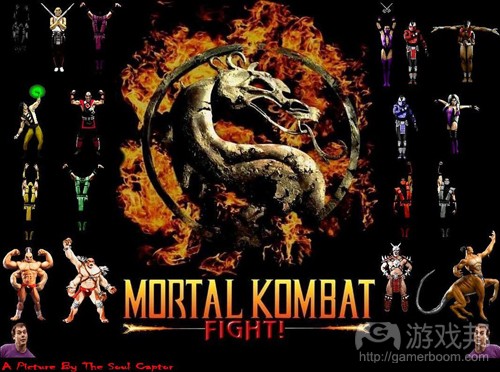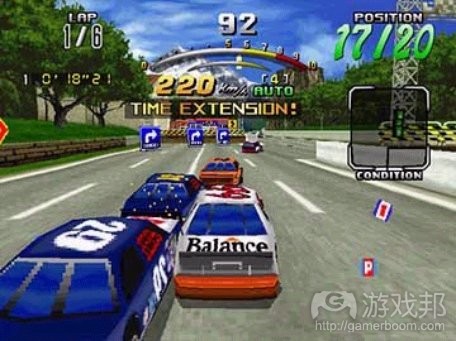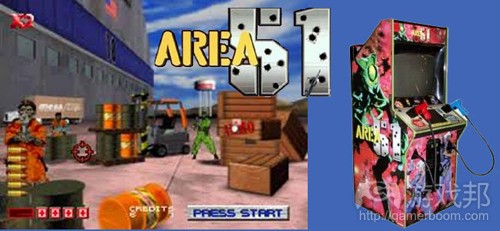阐述投币游戏对PC游戏设计的启示
作者:Jeff Brown,James Plamondon
尽管街机游戏在欧美地区已经不像曾经那么流行,但投币设计对于现在的游戏设计仍然很有价值。本文选自1996年10月版的《游戏开发者杂志》。作者Jeff Brown和James Plamondon概述了“投币的四条法则”。
如果你玩过《Star Castle》、《Defender》、《Mortal Kombat》或《Daytona USA》,那么你一定已经领略过优秀的投币游戏的风采。作为一名PC游戏开发者,是不是好游戏,你一眼就能看出来。但知道游戏的好和知道它为什么好,是不同的;而能够自己设计出一款投币游戏就更加是另一回事了。
本文揭示了经典投币游戏的设计秘密,是根据对世界著名投币游戏设计师的采访整理而成的。随着高端PC游戏兴起为投币游戏设计的新标准平台,PC游戏开发的经验和投币游戏设计的知识相结合,应该能催生一个新的PC投币游戏市场,既能给开发者带来收益,又能给玩家带来乐趣。
法则
我们采访了多位投币游戏设计师,如《Centipede》、《Gauntlet》和《Steel Talons》的设计师Ed Logg、《Capcom Bowling》和《Time Killers》的开发工作室Incredible Technologies的创始人Richard Ditton和Williams及Rare的设计师们。我们提出的开放性问题有:什么投币游戏是最有趣的,为什么,当他们设计投币游戏时会遵循什么原则,等等。至于问题的答案,虽然各不相同,但都赞同如下关键点——这些就是投币游戏的核心设计原则。
对于所有这些法则,如果你愿意,你可以破坏它们,你不使用它们也可能侥幸成功——但在没有完全理解内化这些法则的情况下就违背它们,你的失败率接近100%了。
Brown第一法则:简单而直观
投币游戏的操作、目标、选项和失败的原因都必须简单而直观,让玩家第一次玩就理解。
没有人会阅读投币游戏的说明,至少在他们玩过一把发现操作比他们想象得还难之前(见第四条法则)。投币游戏的简单和直观是什么?也就是,玩家必须能够走到机器面前,投个币,开始玩,第一次玩就能玩得不错,认为自己挺擅长的。如果游戏不能满足这条法则,那么玩家就会投过一次币后就不再玩了。
Capcom的著名游戏《街头霸王2》就完美地体现了这条法则。它的操作组合是一个控制杆和六个按钮。控制杆移动角色的身体,按钮命令角色的拳打脚踢。这六个按钮分成两行。上面三个按钮控制出拳;后面三个负责踢腿—这是对人体上肢和下肢的自然映射。从左到右,按钮效果从快击、慢击到重击。只要快速地随机按键,跟电脑对战上几个回合,任何人都能把《街头霸王2》玩起来。只要玩家玩过几次,有提高水平的渴望,那么他就会读点游戏说明(或简单地摸索一下控制方法),进而发现游戏的操作比自己想象得更有深度。
甚至是休闲的玩家也能看出这款游戏的目标是什么。两个大块头角色对峙,一看就知道一场火拼正要开始。从这款早期的格斗游戏中,玩家可以很清楚地知道自己要做什么:使用自己的角色打败另一个角色。双方角色的一边各有明显的命值条和很大的计时器,正是明确地告诉玩家:把你的对手的命值耗光或者在计时器时间走完时让对手的命值比你的低,你就赢了。
《街头霸王2》的主要选项是角色。这个选项的显示方式也是非常简单直接的。选完角色后,玩家要选择在什么时间用什么攻击动作——基本攻击、角色专属技能、联合技能。这些决定可能是随机按键的结果,也可能是精心(但迅速)计划的策略,取决于玩家的操作水平。每一种攻击动作都是很容易学习的,且通过学习进步的效果非常明显,这就刺激玩家学习得更深入。学习曲线是非常平滑的,使玩家得以按自己的节奏、稳步地提高水平。
投币游戏的核心法则——几乎等于它唯一的法则,是当玩家输掉游戏时,玩家必须很清楚自己为什么会输,并且失败的原因必须表现为下一次容易改正过来的小错误和小问题。玩家必须觉得是自己犯错了,不是游戏胜利了。无论如何,失败的结果只是让玩家觉得自己需要多加练习——“就差四分之一,我就赢了”(战胜上一次令自己失败的挑战)。
Brown第二法则:强反馈
强反馈必须是迅速、准确、详细和一致的。
人有五觉,其中有三种必须体现在投币游戏中,即视觉、听觉和触觉(嗅觉和味觉目前还没探索出来,考虑到格斗游戏的内容,少了这两觉也无所谓)。所有玩家动作都必须通过明显的活动得到强化——适当的声音和力量反馈。力量反馈运用得最好的就是驾驶类游戏,急转弯时打方向盘,或者撞上其他车时的冲击感,等等。正是这些感觉把玩家和角色——交通工具、人物或图标联系起来。通过角色,玩家又与环境产生联系。只有通过迅速而准确的反馈,玩家才能沉浸于游戏创造的体验中。
Sega的《Daytona》是史上最成功的驾车游戏之一,更是遵循这条法则的典范之作。它设置了无闪烁的60帧/秒、50英寸、高分辨率的显示器,给玩家非常即时、准确的视觉反馈。高品质的声音系统传递着重要的声音信息,如当玩家车子打滑时的振鸣场。打方向盘的力量对应压力,影响游戏中的车子——从急转弯到撞击其他车。这种多感觉反馈为玩家创造了更迅速、准确、详细、一致的环境,从而深化玩家对小车和其他游戏元素的交互沉浸感。结果是,《Daytona》被广誉为游戏史上最优秀的投币游戏之一——稳定赢利两年。
Brown第三法则:速度和节奏
投币游戏必须以渐增的速度和节奏告诉玩家挑战难度上升了。
玩家玩游戏是为了接受挑战。这些挑战可以是心理的、身体的或二者兼有。心理挑战通常很花时间。《神秘岛》就是一款经典的心理挑战游戏。但是,它也是一款失败的投币游戏,难怪后来的投币游戏必然倾向于以身体挑战——手眼配合为玩法的核心。
因为这种身体挑战可以在短短的一秒钟以内解决,所以必然要以超快的速度展现出来。“谐调”投币游戏意味着使挑战和奖励保持平衡,在任何时候,对于最大多数可能玩这款游戏的玩家。谐调必须使新手玩家和老手玩家都觉得有挑战性,但可能取得成功,即(通常)在短短一两分钟内打败他们。
Atari的《Area 51》是一款射击游戏,它在速度和节奏上就把握得相当成功。挑战的速度一开始很慢,但会在短期内(一个回合的过程中)和长期内(多次游戏中)慢慢加快。敌人出现在屏幕上的速度和他们的射击的速度都使游戏速度更快。敌人进攻的密度和强度也有明显的分层(越来越多或越来越少)。玩家在低级和中级密度的攻击中会表现得相当好,因此对自己的能力很有信心,知道只有小小地提高技术,就可以战胜上次没有通过的挑战。
Brown第四法则:玩法的深度
为了让玩家继续投币,投币游戏必须在玩家已经反复玩过之后还能吸引玩家。“深度”就是让游戏保持有趣和挑战性的特征。深度可以在身体挑战和心理挑战体现出来。
心理挑战应该在明显的可选方案之间提供简单的选项。在投币游戏设计中最使用最有效的三种心理挑战是设置选项、过程选项和隐藏元素。
比如在赛车游戏中,设置选项包括队伍、赛道或角色,等等。在赛车游戏中,赛车C可能在赛道T上表现得更好;这样玩家就可以选择赛车C和赛道T的组合。
类似地,过程选项是指玩家在游戏过程中遇到的简单的选项。仍然以赛车游戏为例,赛道可能有比较容易的长赛道,也有比较困难的短赛道;为了节省时间,技术水平高的玩家可以选择短赛道。
隐藏元素是指诸如秘密房间、神秘角色等,通常需要玩家知道特定信息才能进入或使用的东西。这些东西通常是玩家通过大量练习发现的或在口口相传中听说的,有时甚至形成专门玩这些隐藏元素的“内部队伍”,许多玩家都希望能成为这种组织中的一员。
身体挑战不仅是投币游戏的核心玩法,而且投币游戏往往通过它来体现深度。仍以《街头霸王2》为例,因为它简单而明显的操作方法,任何人都可以胡乱按键,凭运气打出至少一两次必杀技。但为真正地掌握操作—-能够在最合适的时间打出杀伤力最大的招术,需要极高的技术水平。要达到这种水平,唯一的办法就是大量练习,使玩家能在特定的时间里顺畅地执行必要的动作。
但心理和身体挑战不是绝对分离的。恰恰相反地,只有当选择理想的动作的心理和执行它的肌肉活动都内化成你的本能(上升到禅的境界倒是不必),仿佛你就是角色,你只是在做角色应该做的事,你的技术才能登峰造极。正如传奇日本武士宫本武藏(游戏邦注:他是战国末期与德川幕府前期的剑术家、兵法家,因与佐佐木小次郎决战而一举成名)在他的兵法理论著作《五轮书》(1643)中写道:
“首先,当你拿起剑时,无论如何此时你只有一个信念:杀死对手。你可能抓住、打中、躲过或挡掉对手向你挥来的剑,但所有这些动作都是为了创造打倒对手的机会。你必须明白这个道理。如果你一直想着抓住,想着打中,想着躲过,想着挡掉,那么你就不可能杀死对手。”
游戏设计师的挑战是创造有吸引力的、能刺激玩家为了达到和享受精通而重复地玩的游戏。
启示
本文简要地解释发投币游戏的设计法则。但是,为了全面地理解这些法则,最好能再讨论一下如何在现存的PC游戏中运用它们,使这些PC游戏变成成功的投币游戏。只是篇幅不允许我做这些讨论了,但读者们可以在网上搜一搜相关话题的文章。你会发现很多关于高端PC游戏成为投币游戏的新标准的案例和信息。如果你从事街机或动作类游戏,你确实应该思考一下投币游戏的设计法则。(本文为游戏邦/gamerboom.com编译,拒绝任何不保留版权的转载,如需转载请联系:游戏邦)
We can still learn a lot from coin-op game design
By Jeff Brown and James Plamondon
Though arcades don’t maintain the same presence in the West as they once did, the key takeaways of coin-op design are as valuable today as ever. In this reprint from the October 1996 issue of Game Developer magazine, Jeff Brown and James Plamondon outline ‘The Four Laws of Coin-Op’ to be broken at the designer’s peril.
If you’ve ever played Star Castle, Defender, Mortal Kombat or Daytona USA, then you’ve experienced the pulse-pounding rush of great coin-op game design. As a PC game developer yourself, you know a good game when you see one. But knowing it’s good and knowing why it’s good are two very different things. Being able to design a coin-op game yourself is something else entirely.
This article reveals the secrets of the coin-op masters. It is based on a series of interviews with some of the most successful coin-op game designers in the world. With high-end PCs emerging as the new standard platform for coin-op game design, your experience in PC game development and the experts’ experience in coin-op game design should produce a new market for PC-based coin-op games that can be very profitable to both—and a heck of a lot of fun.
It’s the Law
We interviewed many stars, such as Ed Logg, designer of Centipede, Gauntlet, and Steel Talons, Richard Ditton, founder of Incredible Technologies whose credits include Capcom Bowling and Time Killers, as well as designers at Williams and Rare (makers of Killer Instinct). We asked specific and open-ended questions about what coin-op games were the best and why — and what general rules they used when designing coin-op games. The answers, while varying widely, uniformly agreed on the key concepts described below. These, then, are the core design principles — the laws, if you will — of coin-op game design.
As with all laws, you can break them if you wish, and you may even get away with it — but you’re running a nearly 100% risk of failure if you violate these laws without first internalizing them completely.
Brown’s First Law: Be Simple and Intuitive
A coin-op game’s controls, objectives, choices, and reasons for loss must be simple and intuitive on the first play.
Nobody reads the instructions in a coin-op game, at least not until they’ve played the game and realized that the controls have greater depth than they first imagined (see Law #4, Depth, below). Players have to be able to walk up to the machine, drop in a coin, start playing, and do well enough on the very first play to feel good enough about their performance to think that they (and therefore the game) are pretty darn good. If a game fails to obey this law, the players will walk away after their first coin — a recipe for financial disaster.
Capcom’s phenomenally successful Street Fighter II provides an excellent example of this law in action. Its controls consist of a joystick and six buttons. The joystick moves your fighter’s body, and the buttons activate kicks and punches. The six buttons are arranged in two rows. The three upper buttons control punches, while the three lower buttons control kicks — so there’s a natural mapping between upper body (which correlates to the upper buttons) and lower body (which correlates to the lower buttons). From left to right, the buttons progress from faster, lighter blows to slower, heavier blows. Anyone can just walk up to Street Fighter II and do pretty well in the first couple of rounds against the computer just by pounding quickly and randomly on the buttons. Once they’ve played a few times and have built a desire to improve, players might read the few simple instructions (or simply explore the controls’ behavior) and realize that the controls have greater depth.
The objective of the game is obvious to even the most casual passers-by. Two large, tough-looking characters start each game facing each other in stances that suggest impending confrontation. Even from the early days of the fighter genre, this was more than enough to teach a player what he was supposed to do: use his character to beat the crud out of the other character. Distinct life energy bars on each player’s side of the screen and a large centralized timer communicate the specific objectives—namely, pound your opponent until his life energy is gone, or at least drive it lower than your own bar before time runs out.
The primary choice in Street Fighter II is which character to use, and this choice is presented in a simple, obvious manner. Afterwards, the player chooses which attack to use at which time — the basic attacks, character-specific attacks, and combo attacks. These decisions can be the result of randomly pounding the controls or of extremely deep (but fast) tactical planning, depending on the skill level of the player. Each individual attack is easy to learn, and the degree of improvement resulting from the player’s learning just one move is significant, encouraging players to learn more. The learning curve is smooth, allowing the players to improve their understanding steadily, and at their own pace.
A cardinal rule of coin-op — almost worthy of its own law — is that when a player loses the game, it must be obvious to that player why he or she lost, and it must appear to be a simple matter to correct the mistake and win next time. The player has to feel that he or she lost, not that the game won. The failing is with him or her, and the player should feel that with just a little more practice — “just one more quarter” — he or she can win the game (that is, overcome the specific challenge that defeated him or her last time).
Brown’s Second Law: Deliver Strong Feedback
Strong feedback must be fast, accurate, detailed, and consistent—involving the player’s senses as fully as possible.
Of the five senses, three should be engaged in coin-op games: sight, hearing, and touch. (The frontiers of smell and taste are so far unexplored, which — considering the content of fighting games — is just fine with us.) Every player action must be reinforced by visible action — an appropriate sound and, ideally, force-feedback. Force-feedback is best known from driving games, in which the steering wheel shakes from the “strain” of a tough turn, or jumps from bumping against other cars, and so on. This multi-sensory feedback links the player and avatar — the vehicle, character, or icon. Through the avatar, the player is linked to the game environment. Only through fast and accurate feedback can the player get lost in the experience the game offers.
Sega’s Daytona, one of the most successful driving games ever, is a great example of this design law in action. It puts out a flicker-free 60 frames per second on a 50-inch, high-resolution monitor, giving the player very fast, accurate visual feedback. The high-quality audio system delivers important audio feedback, such like squealing sound when the player’s car starts to slide. Force-feedback “pushes back” on the steering wheel, in response to the stresses affecting the car in the game — from pulling Gs in tight turns to bumping against other cars. This multisensory feedback gives the player fast, accurate, detailed, consistent — and therefore immersive — information about his car and its interaction with other game elements. As a result, Daytona is widely regarded as one of the best coin-op games of all time — and it’s been making money steadily for two years.
Brown’s Third Law: Deliver Pace and Rhythm
A coin-operated video game must deliver challenges to the player at a fast, steadily increasing pace, delivering rhythmic pulses of additional challenges.
People play games to be challenged. These challenges can be mental, physical, or both. Mental challenges usually take time to work out. Myst is a great example of a mentally challenging game. It’s also a great example of a game that would flop miserably in coin-op, which is why coin-op games invariably prefer physical challenges — challenges of eye-hand coordination — to mental challenges, as the core of game play.
Since such a physical challenge can be presented and overcome in a fraction of a second, such challenges must be presented at a rapid pace. “Tuning” a coin-op game means sustaining the right balance between challenge and reward, at all points in the game, for the largest group of people who might play the game. Tuning has to make both the first-time player and the master player feel challenged and successful, while still defeating them in (generally) one-and-a-half to two-and-a-half minutes per credit.
Atari’s Area 51, a recent gun game, has succeeded in large measure to its excellent tuning of pace and rhythm. The pace of challenges is slow at first, and picks up gradually both in the short term (during the course of a single play) as well as in the long term (over multiple plays, as the player advances farther into the game). Both the rate at which enemies appear on screen and the speed with which they shoot at you after they appear are used to increase the pace. Threats come in distinct waves, ranging in intensity from light (enemies come more or less one at a time) to heavy (Yikes! They’re all over the place!). Players do well enough during light and medium waves to feel good about their abilities and know that even a small improvement in skill (“just one more quarter…”) will get them past the wave that they failed to shoot their way through last time.
Brown’s Fourth Law: Offer Depth of Play
To continue to draw in coins, a coin-operated video game must engage a player’s interest even after repeated play. “Depth” is that characteristic of a game that keeps it interesting and challenging. Depth can be provided through physical challenges or mental challenges.
Mental challenges should offer a simple choice between obvious alternatives. The three kinds of mental challenges most effectively employed in coin-op game design are set-up options, mid-play options, and hidden elements.
Set-up options include things like different teams, racetracks, or characters. In a racing game, a given car may do better on one track than another; having the player choose both the car (c) and the track (t) creates (c*t) combinations that the player can explore.
Similarly, mid-play options give players simple choices during the course of a game. For example, in a racing game, the track may include a long easy stretch and a relatively difficult shortcut, tuned such that only the skilled player would be able to save time by taking the shortcut.
Hidden elements are things like secret rooms, secret characters, and so on which generally require that the player know special information. These frequently are revealed only by extensive gameplay and word of mouth, creating an “inside group” of which many players will wish to be a part.
Physical challenge not only forms the core of coin-op gameplay, but is usually the primary contributor to depth as well. Consider the simple and obvious controls of Capcom’s Street Fighter II. Anyone can walk up, pound away at the buttons, and get at least a few good blows in, by luck alone. But to truly master the controls — to be able to deliver a specific three-blow combination perfectly timed to maximize its effect on the opposing character — takes a great deal of physical skill. This skill can be acquired only through extensive practice, which trains the player’s muscles to perform the needed actions smoothly.
But the separation of mental and physical challenges is not pure, quite the contrary. The pinnacle of mastery is achieved only when the mental challenge of selecting the ideal action, and the physical challenge of delivering it, merge into a mentally elevated state of being (not to get too Zen-like here), in which you simply are the character, and simply do the right thing. As Miyamoto Musashi, the legendary samurai duelist, wrote in his Book of Five Rings (1643):
“First of all, when you take up the sword, in any case the idea is to kill an opponent. Even though you may catch, hit, or block an opponent’s slashing sword, or tie it up or obstruct it, all of these moves are opportunities for cutting the opponent down. This must be understood. If you think of catching, think of hitting, think of blocking, think of tying up, or think of obstructing, you will thereby become unable to make the kill.”
The game designer’s challenge is to create a game that is sufficiently compelling, that the player is stimulated to play again and again, in order to reach and enjoy this level of mastery.
Learning By Example
This brief overview of the Laws of Coin-Op is now complete. To understand these laws fully, however, it would be useful to discuss how the Laws would be applied to existing PC games in the main coin-op genres, to turn them into potentially successful coin-op games. Space does not allow such a discussion here, but you’ll find exactly that discussion — plus information on the great guys who contributed their wisdom and experience to the creation of this paper — elsewhere online. You’ll find these examples and a lot of other information on the emergence of the high-end PC as the new standard for coin-op video game deployment. If you’re working on an arcade or action-style game, you should be thinking about coin-op — and the information on our Web site will help you get started.(source:gamasutra)











































 闽公网安备35020302001549号
闽公网安备35020302001549号